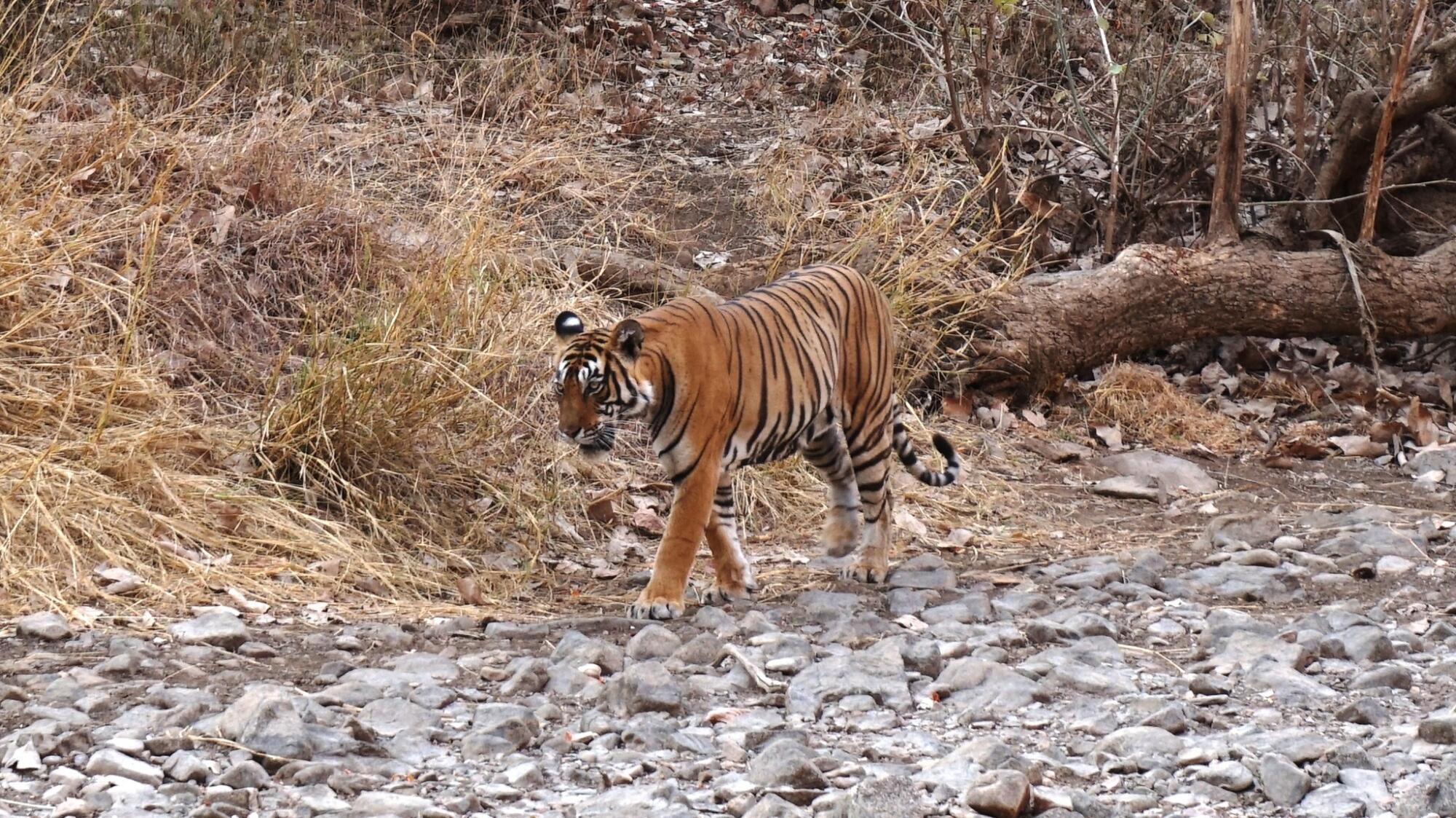- Share via
Ranthambore National Park, India — In a gravelly riverbed blooming with dry desert brush, conservationist Dharmendra Khandal pointed to the spot where villagers once set a deadly trap for two young male tigers.
A few years ago, a tiger had wandered into a field at the edge of Ranthambore, a famed wildlife reserve, and mauled two goats belonging to a local farmer. In retaliation, he injected pesticide into the goat carcasses, a common method of killing tigers who return to feed on their slaughter.
Two goatherds walked alongside Khandal, nodding in understanding. Their community had long viewed tigers as a threat. But instead of opposing the great predator, they have become unlikely players in a decade-long battle to save it.
Armed with special cameras, 30 villagers have collected the most detailed records ever of the movements of the big cats along the edges of one of India’s main tiger sanctuaries. Their work has offered new information about the pathways tigers use to move in and out of the reserve, giving officials a chance to protect the endangered species’ habitat in the ever shrinking forests of central India.
The innovative project comes as India’s tiger population – the largest in the world – experiences a remarkable comeback.
In 2006, a national census found that as few as 1,165 tigers remained from an estimated population of 45,000 a century ago. Poaching, shrinking habitats, disappearing prey and conflicts with humans posed such a threat that conservationists worried that the 10-foot cat would someday become extinct.
By 2014, however, India’s official tally of tigers had almost doubled. That drove the worldwide population of wild tigers up to at least 3,890 this year – the first recorded global increase after decades of decline.
Indian authorities had evolved more accurate counting methods, but conservationists agreed the recovery was also due to improvements in India’s forest service and greater local efforts to combat poaching and other human threats.
At the center of the battle in Ranthambore is Khandal, a tall, thick-mustached scientist who runs an organization called Tiger Watch out of a prefab office outside the national park in the northwestern state of Rajasthan.
Khandal, 42, has watched the tiger population of the park – a former hunting ground for Rajasthani royals – swell from 18 in 2005 to as many as 60 adults and cubs today. About 10 tigers are born every year now in and around Ranthambore, offering tourists hardy enough to withstand 115-degree summer heat among the best chances anywhere to see the animals in the wild.

On a scorching morning recently, a cluster of jeeps and open-top buses gathered below a rocky hillside to observe the tigress Mala, or “necklace,” named for the broken stripes along her side that resemble a string of beads. After a long, lazy stretch, Mala suddenly stood up. Instantly, she darted across a bed of rocks and into a clutch of golden brush where she had spotted a large sambar deer.
Mala clawed at the giant prey, then climbed on top and smothered the fallen deer. Tourists stared slack-jawed as Mala lay there for several minutes before dragging the fleshy body up the hillside under the shade of a tree.
“It’s much easier to see the tigers than before,” said a rail-thin guide with thick black hair who goes by Ved, who has worked here for two decades. “But the disturbances to the park and the animals are more and more.”
More than 150 villages are within a little more than a mile of Ranthambore’s boundaries, a thick human density that would challenge any wildlife sanctuary but particularly one that houses tigers – the ultimate solitary beast.
As the tigers range farther afield to find space and prey, it has put them in increasingly direct conflict with farmers and herders.
Last year, a 10-year-old male popularly known as Ustad (meaning “master”) was confined to captivity after he mauled a park ranger, his fourth human victim in five years. This March, a tigress known as T-35 who left the park years earlier was found dead of a suspected poisoning in a forest 70 miles from Ranthambore.
T-35’s journey underscored that Ranthambore is part of a network of tiger habitats stretching across hundreds of miles. To ensure that the population continues to thrive, forest officials are trying to map and protect the corridors tigers use to move in the wild.
“The challenge now isn’t that the tiger population is declining – it’s that it’s growing,” Khandal said. “Inside the park is the forest department’s job. But it was becoming clear that you also had to look at was going on outside.”
He found allies in the Gujjars, a tribal community that raises sheep and goats in the scrubland ringing the park.
In early 2013, Khandal met Hanuman Singh Gujjar, a goatherd who was working with the state forest department. For about $25 a month, Gujjar would send forest officials information about tigers he spotted near the windswept fields outside the park where he lived.
When the forest department stopped paying Gujjar, saying they couldn’t afford to hire him full time, Khandal stepped in with funding from Tiger Watch. A young male tiger was on the move from Ranthambore. Khandal gave Gujjar a camera trap – a camera fitted with an infrared motion sensor, used to capture images of animals in the wild – and the goatherd set off on an old motorcycle.
The challenge now isn’t that the tiger population is declining – it’s that it’s growing.
— Dharmendra Khandal, Tiger Watch
Over the next six weeks, Gujjar followed the tiger through the bush for nearly 150 tire-blistering miles, tracking its pug marks, capturing photos and marking GPS positions on a cellphone.
“We realized how much time they take, how far they travel, the routes they use to cross rivers and canals,” Khandal said. “It fine-tuned our knowledge.”
With forest department support, Khandal now employs about 30 villagers as wildlife trackers, paying each about $40 per month.
On a recent afternoon, his cell phone buzzed every few minutes with photographs from the trackers’ cameras. Hidden behind tree branches or near the carcasses of prey, the cameras have obtained images of elusive predators such as tigers, leopards and even the caracal, a pointy-eared cat that is a rare sight in Ranthambore.
The information has helped forest officials chart three corridors tigers use to move between Ranthambore and the nearby Kailadevi sanctuary. Last month, authorities finalized a proposal to relocate five villages and compensate residents to reduce pressure on the pathways.
“These villagers have done some extraordinary work so far,” said Y.K. Sahu, field director at Ranthambore. “What we have discovered is we can’t work in seclusion. We need help from the local population.”

Khandal, who holds a doctorate in wetland ecology, does not consider himself a tiger expert. Smaller animals have long been his passion. His cellphone ring tones are bird calls, and he devoted his early career to discovering new spider species in Indian forests.
When he was hired by Tiger Watch in 2003, poaching was the gravest threat to the predators, due mainly to demand in China for tiger parts that are used in traditional medicines, worn as charms or eaten as delicacies.
Khandal went after the killers with brio, leading raids on suspects’ homes that helped authorites capture more than 70 people, 40 weapons and dozens of skins.
Yet poaching and seizures of tiger parts are rising. The Wildlife Protection Society of India says at least 30 tigers have been lost to illegal killings in the first half of 2016, the most in any six-month period since the group began tracking the crimes eight years ago.
“India may be doing well in terms of numbers of tigers, but the poaching problem and demand from China is getting worse,” said Belinda Wright, the society’s executive director.
The wildlife trackers in Ranthambore have gathered dozens of tips on poaching networks and passed them onto authorities. They have found and defused crude bombs used to kill small animals – made of gunpowder packed into balls of dough – that deprive predators of their prey and have sometimes injured humans.
Last month, a camera trap captured an image of two men on a motorcycle with a high-powered flashlight and guns slung over their shoulders. Police tracked down the bike but the suspected poachers remain at large.
“People here want to protect the tigers; we just want to make sure that we, too, are protected,” said Naresh Gujjar Sawta, 28, who has worked with Tiger Watch since 2014. “We all live in this forest so it makes sense that we look out for them.”
For more news from South Asia, follow @SBengali on Twitter
ALSO
Scientists deploy ‘Frankenturtles’ in Chesapeake Bay to boost survival of loggerheads
Rare toads (presumably) love him; off-roaders do not
More to Read
Sign up for Essential California
The most important California stories and recommendations in your inbox every morning.
You may occasionally receive promotional content from the Los Angeles Times.











